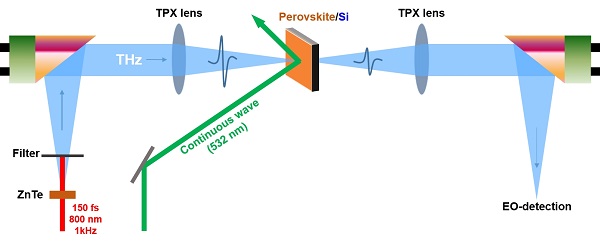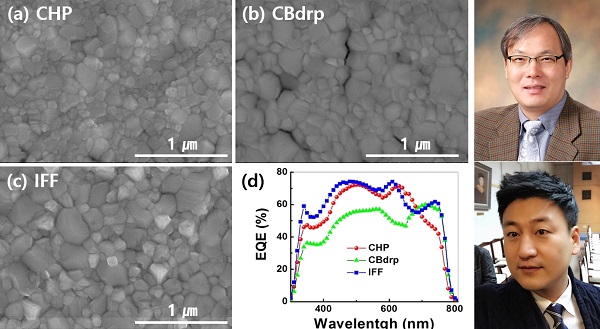Media Center
A multimedia mosaic of moments at GIST
GIST Excellence
[Press Release] Professor Do-Kyeong Ko"s research team develops terahertz wave modulation device with laser intensity reduced to 25%
- 엘리스 리
- REG_DATE : 2016.12.12
- HIT : 875
Professor Do-Kyeong Ko"s research team develops
terahertz wave modulation device with laser intensity reduced to 25%

(Figure 1) Perovskite-silicon double junction structure based terahertz modulation characterization system. An experimental design of a femtosecond laser-based terahertz wave spectroscopy system in which a green continuous wave laser is irradiated onto a modulation device. Terahertz beam guide with generation and detection of ZnTe-based broadband terahertz waves (0.2-2 THz) and two pairs of off-axis parabolic mirrors and TPX lenses. Controls the transmission amplitude of the terahertz wave in the perovskite-silicon composite structure according to the laser operating intensity.
□ The National Research Foundation of Korea has announced that Professor Do-Kyeong Ko"s research team at the Gwangju Institute of Science and Technology (GIST) has developed a high-efficiency terahertz wave modulation technology that will help reduce the cost of wireless communication by using perovskite as the solar cell element.
□ Terahertz waves are mainly used to find dangerous hidden items in packages or to reconstruct ancient cultural artifacts because the electromagnetic waves that vibrate 100 billion times per second can penetrate various objects. The technology is specially used in medical imaging and wireless communication for transmitting information using electromagnetic waves.
O In the above case, a technique of modulating the amplitude of the electromagnetic wave is required in order to transmit various information. Terahertz wave amplitude modulation methods include mechanical shielding, electrical control, and photoconductivity * using lasers and semiconductors.
* Photoconductivity: When a light is irradiated on a semiconductor, electrons are generated on the conduction band and the conductivity increases, which is also known as the internal photoelectric effect.
O The modulation device used in the photoconductive method is mainly made of a double junction structure of a material such as graphene, a metamaterial, an organic / inorganic compound, and a silicon semiconductor, and has a high modulation efficiency.
□ Perovskite has excellent light absorbing power and photovoltaic effect *. Recently, it has been attracting attention as a substitute for solar cells because it is easy to manufacture and low cost manufacturing is possible. The team focused on the advantages of perovskite, efficient photoelectric properties and ease of fabrication, and used it to develop terahertz wave amplitude modulation devices.
* Photovoltaic: The effect of converting light energy into electrical energy.
□ Professor Do-Kyeong Ko"s research team made a perovskite-silicon double junction optical device using a perovskite element as the solar cell element.
O The fabricated composite optical device has the same modulation efficiency even when the operating intensity of the laser is only 1/4 of that of the conventional silicon device thereby reducing both the amount of power required for operating the device as well as the manufacturing cost of the device.
O Terahertz wave modulation is achieved efficiently by adjusting the intensity of the green laser light. Green light accounts for the largest percentage of the solar spectrum available on Earth.

(Figure 2) Perovskite material produced through solution process. Percentage of perovskite surface images and their associated external quantum efficiency. It exhibits high external quantum efficiency at a wavelength of about 532 nm.

(Figure 3) Terahertz wave modulation characteristics based on perovskite-silicon composite structure. (A) Terahertz wave modulation characteristics and (b) terahertz wave spectral modulation characteristics in the CHP process. (C) Modulation efficiency according to the intensity of laser operation by process method. The amplitude modulation of the terahertz wave changes according to the intensity of the laser to be irradiated, and the higher the intensity, the greater the modulation width. Amplitude modulation efficiency of each process method is highly observed in the CHP and IFF process methods and exhibits a high modulation efficiency of about 70%.
□ Professor Do-Kyeong Ko said, "This achievement lays the foundations for the development of a low-power, high-efficiency terahertz wave modulator whose laser operating intensity is reduced by a factor of four compared to a single semiconductor structure, which will greatly reduce the cost."
□ The results of this research, which was supported by the Ministry of Science, ICT and Future Planning, was published on November 24, 2016, in Scientific Reports.